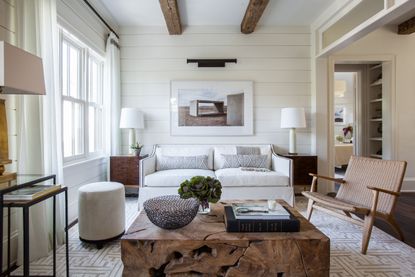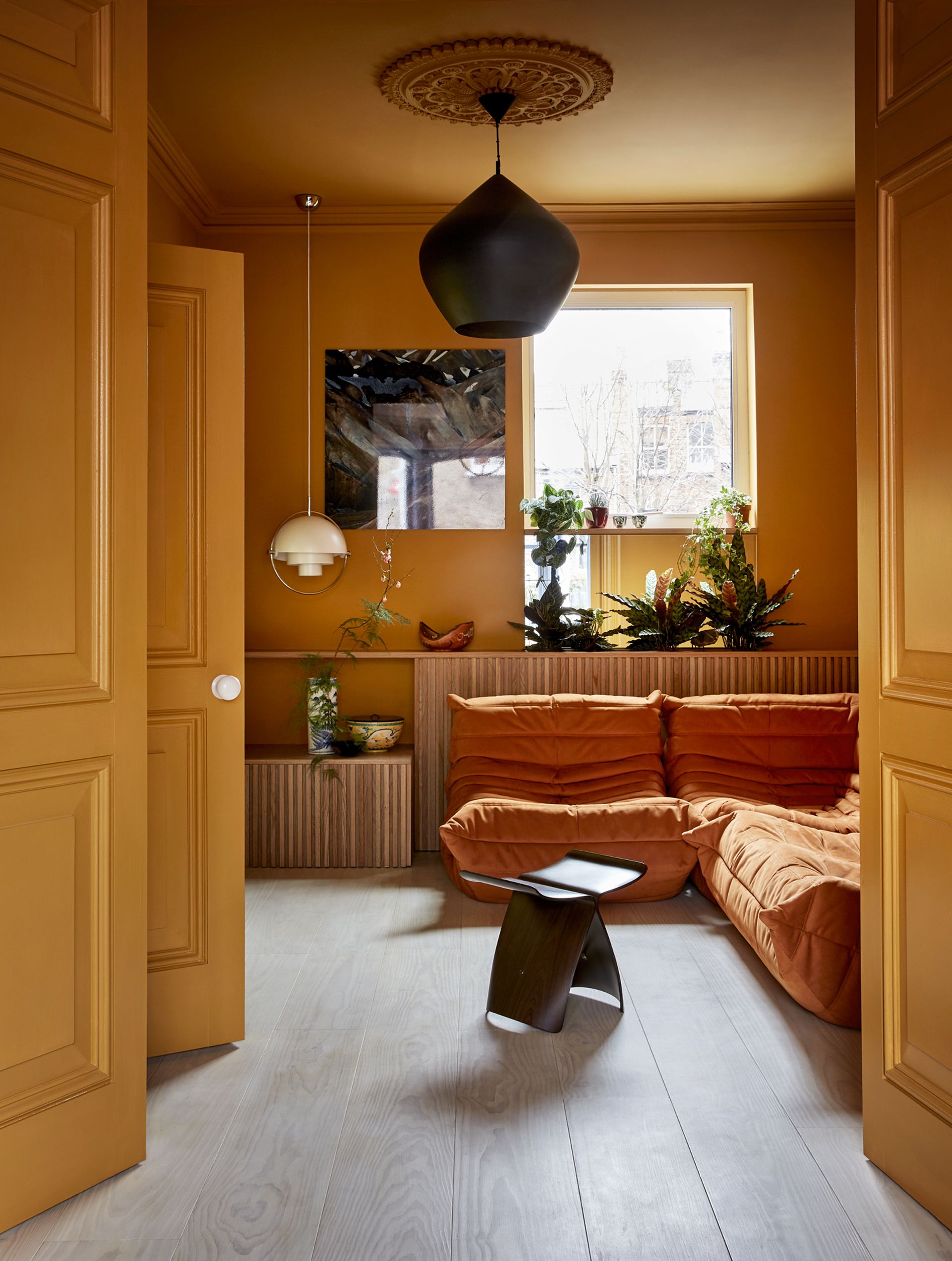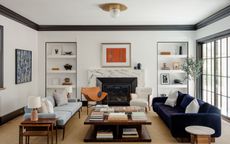10 Rules For Decorating Small Spaces - How Designers Create A Cozy Room That Also Boosts The Square Footage
Experts reveal their tips and tricks on how to combine a welcoming vibe with space-stretching interior design techniques

Petite pads can offer up some design challenges, but this doesn't mean you can't create a chic room that also employs some clever space-boosting tricks into the bargain.
And, when it comes to rules for decorating small spaces, interior designers suggest there's no reason you can't pack a big style punch in a bijou room.
First of all, don't be afraid to use a deep color in a small living room; lighter colors will offer an expansive feel but, particularly when employing a color drenching technique, darker colors can also create a cozy and airy space.
Use clever storage solutions to keep clutter at bay, whether it's bespoke joinery or multifunctional furniture. Visual clutter will always make a room feel smaller, and will also create an unwelcoming environment. And remember: just because the room is small doesn't mean your furniture or decor items have to be too. The opposite can actually be true, and investing in statement pieces of art or hanging large mirrors can make a space feel grander.
10 rules for decorating small spaces
We've chatted to the experts to find out more top tips on rules for decorating small spaces below.
1. Choose quality over quantity

When it comes to selecting decor pieces for a bijou room, small space design tips tell us that curating a quality collection - as opposed to buying bits and pieces on a whim - is always best.
'Simplify your space with a discerning eye, opting for quality over quantity when selecting decor elements,' says Marie Flanigan, Principal, Marie Flanigan Interiors.
'Thoughtfully edit your belongings, curating a collection that reflects your personal style while maintaining a sense of openness and tranquility. Channel simplicity as the ultimate sophistication by carefully curating decor items and accessories. In smaller spaces, every element should contribute to a harmonious narrative, fostering a sense of curated elegance no matter the space.'
2. Get rid of clutter

'Possibly the most simple and effective way to improve the look and feel of your home is by thoroughly decluttering and organizing it,' says Juliette Thomas, Juliettes Interiors. 'To create the chic designer aesthetic means minimizing what is on display and streamlining your possessions.'
The 80/20 decluttering rule is a nice one to follow. Or a good tip for keeping things clutter-free is to mainly invest in items that have a purpose.
Juliette continues: 'Any great interior designer will tell you that there should be a suitable place for anything you bring into your home, whether it’s books, ornaments, table lamps or even cushions - so hide away what you can into organized storage behind closed doors, whilst still ensuring your personality shines through.
'A clutter-free home not only looks aesthetically pleasing, but it is also known to have significant mental health benefits, as the saying goes ‘tidy home, tidy mind’.'
The book Keep the Memories, Lose the Stuff by Matt Paxton is a really wonderful guide to helping you reframe your mind.
3. Invest in multifunctional furniture

Multipurpose furniture is an important element for creating a successful petite room, and is a crucial rule for decorating small spaces.
Liz Potarazu, CEO and Principal Designer of the Maryland-based LP + Co, advises: 'Opt for pieces with built-in storage, like beds with drawers, coffee tables and even side tables with doors or drawers.
'If you have an unused nook or alcove, creating built-in shelving is a great way to add storage without adding another piece of furniture into the mix.'
And Marie Flanigan adds: 'Thoughtful furniture selection is paramount - opt for multifunctional pieces that marry form and function, strategically placing each item to maximize both utility and aesthetic appeal.
'Don't overlook the efficiency of hidden storage solutions to seamlessly tuck away everyday essentials, ensuring that each item in the room serves a purpose and contributes to an atmosphere of uncluttered sophistication.'
4. Embrace your vertical space

Unused wall space is wasted space in a small room. We're not suggesting you cover every inch, but do make the most of your vertical space where you feel it works aesthetically.
This can be in the form of bespoke storage solutions, like fitted wardrobes in a small bedroom, floor-to-ceiling cupboards in a narrow utility room, or open shelving in a kitchen.
Marie Flanigan comments: 'Embrace the power of vertical space, utilizing built-ins and storage solutions to free up floor area, allowing the room to breathe while showcasing cherished objects.'
5. Layer your lighting

'Lighting always makes a huge impact,' states Marie Flanigan. 'Layer ambient, task, and accent lighting for depth and visual interest in a small space.'
Avoiding table lamps is a handy small space design tip that helps free up precious floor space. ‘When you have a small room, making the most of the space is important,’ says Linda Hayslett of LH.Designs. ‘Having sconces on the walls so you don't crowd your nightstands or side tables is a great space-saving idea.’
LP & Co's Liz Potarazu explains further: 'For lighting in a small space, go with pendant lighting or sconces instead of table lamps. These allow you to keep the space less cluttered (you don’t need to have a piece of furniture for a table lamp to sit on) and they visually draw the eye upward.'
She continues: 'Additionally, in smaller spaces, you likely want to opt for flush mount lights as opposed to a chandelier.'
A pendant or chandelier can work well, however, over spaces that are not walked under. For example, in the small guest house designed by Marie Flanigan (above), the pendant over the kitchen table and over the bed are visually pleasing as well as working to help zone the space.
6. Take time to reflect

It's a well known interior design rule that using mirrors will help to make a small space feel more expansive thanks to their reflective qualities.
So where is the best place to hang them? 'Mirrors can always make a narrow room appear larger, just make sure that your mirror is adjacent to any windows to the outside of the home so that they aren’t reflecting sunlight and creating glare,' says Liz Potarazu.
'Using mirrors across from a wall with art also serves a double purpose of decorating the other side of the room through the reflection!'
You can also use mirrors in unexpected ways to maximize their space-stretching qualities. For example, in the small living room by interior design team Husband Wife (above), space is cleverly enhanced by subtly adding a mirrored back to the open shelving.
7. Consider the type of room you're decorating

Take the room type and its use into consideration before you pick up the paint brushes. Why? Some small rooms lend themselves to being more creative with designn and color palettes than others, suggests Ruth Mottershead, Creative Director, Little Greene.
She explains: 'Before decorating a small space, consider how you use the room, as the approach to a transitional or infrequently used space, such as a small entryway or narrow utility room, will differ from the approach to a small kitchen or bedroom, where you will spend more time.'
Ruth continues: 'Think about the atmosphere you are looking to create, if it’s a space such as a small laundry room or powder room, these are wonderful areas to really follow your heart and go bold with color and pattern; forget about the size of the room and embrace colors you have always wanted to use but haven’t felt confident enough to.
'In a small bedroom or small living room consider a more cohesive and harmonious approach, a limited colour palette will make a space feel considered and expansive.'
8. Try color drenching for a cozy AND expansive feel

Color drenching - a modern interior design trick that sees the walls and ceilings all painted the same shade - is a great way to create an inviting space that also feels expansive. And the good news? Light or dark colors both work well in a small space.
'One of my favorite ways to decorate a small space or a space with low ceilings is to paint everything one color: walls, trim, ceiling, doors,' says Liz Potarazu. 'Your eye isn’t drawn to the breaks, it’s more visually seamless, giving the illusion of a larger room.'
And Little Greene's Ruth Mottershead agrees, saying: 'Small spaces are a wonderful opportunity to embrace the color drenching trend, which takes a single, or closely related color across all aspects of a space, from skirting and walls to ceilings and doors.
'This can include wallpapers too, with tonal designs paired with coordinating paint colours to create cohesive immersive interiors. By drenching an interior in one single colour and incorporating all elements within the space, you can create a truly engaging scheme even in a small space.'
Colour drenching can be achieved with any color, from soft, muted pastels to deep, intense shades.
Ruth adds: 'It's particularly effective when using mid-strength tones such as ‘Garden’, ‘Etruria‘ and ‘Giallo’. These strong, vivid hues work beautifully to create an enveloping space that allows colour to be the focal point.
'For a really cozy, inviting feel, consider the soothing power of deeper shades; darker sumptuous colors such as 'Chocolate Colour’ or ‘Cordoba' can give a small space a luxurious and intimate atmosphere.'
9. Think about furniture color and placement

The color of your furniture can look big or small depending on if it compliments, blends or contrasts the color on your walls - so it's an important factor to consider when decorating a small space.
Linda Hayslett, of LH.Designs, explains: 'If you chose a monochrome color palette but your walls are a dark blue and you pick a dark blue sofa, the furniture will blend away and disappear into the wall making the room feel bigger than it is. But if you had a white wall and a black sofa, it can make the room feel smaller against the contrast of the two hues. However complementary colors can also make a room look larger if their undertones match because your eye isn't bothered by such a jarring difference in colors.'
Scale and placement is also important when it comes to small rooms. Linda says: 'The furniture you choose affects the visual size of a room depending on the scale of each piece. In a small living room, for example, a sectional is a larger sofa so can make a room feel more closed in at times as opposed to having two separate sofas facing one another because it feels more open. Depending on what your needs are, making sure of size and function will be important to having an impact in a small space.
'Though colors play a part in how a living room can feel in size, contrary to belief, in dark versus light colored furniture or wood, it's not the color that always makes a space feel small or big. It's more so the scale, placement and how each piece relates that can feel small vs big. I've been in many rooms that felt small that had lighter colored furniture, but they didn't flow together so it was all making it feel tiny.'
Some well-placed larger-scale pieces can make a small room feel more expensive, a well as bigger. And, yes, you can definitely put a big couch in a small living room - just not so large that it restricts flow around the room.
10. Don't forget the importance of bespoke storage solutions

Whether you're decorating a small home office, living room or bedroom, bespoke storage is key to creating a streamlined and clutter-free space.
'The secret to making a small space look and feel bigger is to keep clutter at bay,' says Irene Gunter, founder, Gunter & Co. 'My number one tip for achieving this is with made-to-measure cabinetry. Tailored to the dimensions of your space, the cabinetry can be designed to work around any quirks, such as sloping ceilings or awkward corners. Going bespoke also means you can adapt the internal layout of your cabinetry to what you want to store.'
She continues: 'In a small bedroom, I recommend taking wardrobes all the way to the ceiling to make the most of what would otherwise be dead space. It's also a good idea to decorate the wardrobe doors with the same paper or paint used on the walls. This creates a cohesive feel with very few distractions for the eye, which is a savvy way to increase the sense of space.'
Be The First To Know
The Livingetc newsletter is your shortcut to the now and the next in home design. Subscribe today to receive a stunning free 200-page book of the best homes from around the world.
Ruth Doherty is a lifestyle journalist based in London. An experienced freelance digital writer and editor, she is known for covering everything from travel and interiors to fashion and beauty. She regularly contributes to Livingetc, Ideal Home and Homes & Gardens, as well as titles like Prima and Red. Outside of work, her biggest loves are endless cups of tea, almond croissants, shopping for clothes she doesn’t need, and booking holidays she does.
-
 'Subtle Gray' Is The New Color Trend Designers Are Using to Replace White — It's So Much Warmer and More Luxe
'Subtle Gray' Is The New Color Trend Designers Are Using to Replace White — It's So Much Warmer and More LuxeIt’s the new shade grabbing designers’ attention and you should know about it. But what is ‘subtle gray’, and how can you use it?
By Raluca Racasan Published
-
 Exactly When to Fertilize a Lawn After Winter — Experts Guarantee You a Beautiful Backyard All Year
Exactly When to Fertilize a Lawn After Winter — Experts Guarantee You a Beautiful Backyard All Yearif you know when to fertilize a lawn after winter then you can set yourself up for a well manicured and healthy backyard all year long
By Jacky Parker Published

